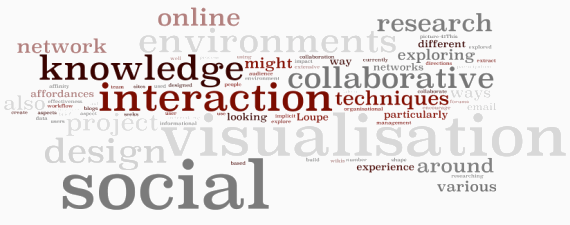Loupe explored the visualisation of electronic spaces, such as email, blogs, wikis, forums and other social software, used for Knowledge Management. It aimed to find new ways to view and manipulate large amounts of information from within these resources so that relationships, trends and tacit social networks could be seen and used to create and retain knowledge.
information is not knowledge
As systems for managing content improve, we need help making sense of what this content represents. Increasingly, social software is being used in organisations for Knowledge Management, but as the amount of information grows, it is harder to understand the knowledge represented by an object of information. This impacts on productivity in a significant way – when people spend small amounts of time finding information (because search tools are becoming so effective) but more time working out what to do with the piece of information they found.

traditional + contemporary approaches
While Knowledge Management technology was not new and visualisation had been used for many years by large organisations to quickly make sense of large amounts of complex data, none of these tools or services addressed the explosion of social media, which was increasingly being integrated into enterprise IT solutions.
Most best-of-breed enterprise solutions sought to apply Web 2.0 technologies and concepts to traditional Content Management Systems. While this was an improvement on older Knowledge Management approaches, users quickly found it didn't matter if they could find everything or even see what other people are doing with tags. The presentation formats and user interfaces often interfered with their ability to discover or create new knowledge and collaborate with colleagues. This represented a real opportunity to design and develop tools that help make sense of the enormous amounts of information available within email, blogs, wikis and other social software platforms.
research + development approach
In the short term, the Loupe project developed a web-based prototype of a visualisation plugin or module compatible with a number of popular email clients and a cross section of users were solicited to test the prototype in a private beta environment. At the same time, the project's research team looked at usage scenarios for organisational knowledge management systems, with a particular focus on the way email was used within organisations.
In the medium term, the Loupe project continued to develop the prototype Knowledge Management module based on ideas garnered from research within the group and based on feedback from the beta testing community. The project's choice of a plugin designed to work with email clients was because email was the most widely used social knowledge environment, and consequently there were more issues concerning knowledge management that related to email than to other environments. The choice of email as a platform for the plugin also ensured that this community was a large and effective one, due to the ubiquitous nature of the platform. A range of visualisations were be presented to the beta group for testing and case studies of the prototype's effectiveness as a knowledge management tool within organisations were collected.
expected research outcomes
Loupe aimed to find ways of presenting dynamic high-level overviews of the networks of objects (documents, people, comments, media, etc) inside enterprise Content Management Systems, to provide visual representations of the knowledge these networks of objects hold, for example, by moving through the 3-Dimensional knowledge space to gain a helicopter-like view of what was happening in an organisations intranet, with the opportunity to drill deeper and look at content from different perspectives to identify different relationships.
The challenges to creating a dynamic visual interface to networks of data objects included deciding how information should be represented and manipulated, and how relationships between objects should be represented and manipulated.